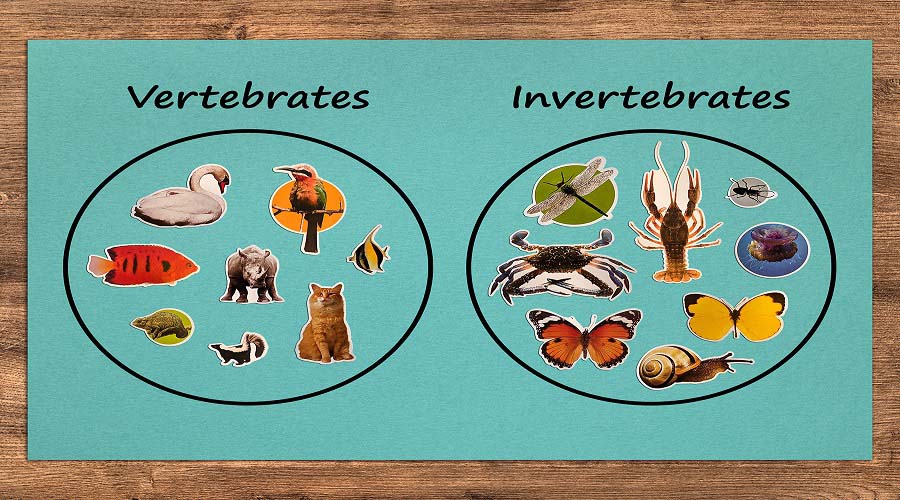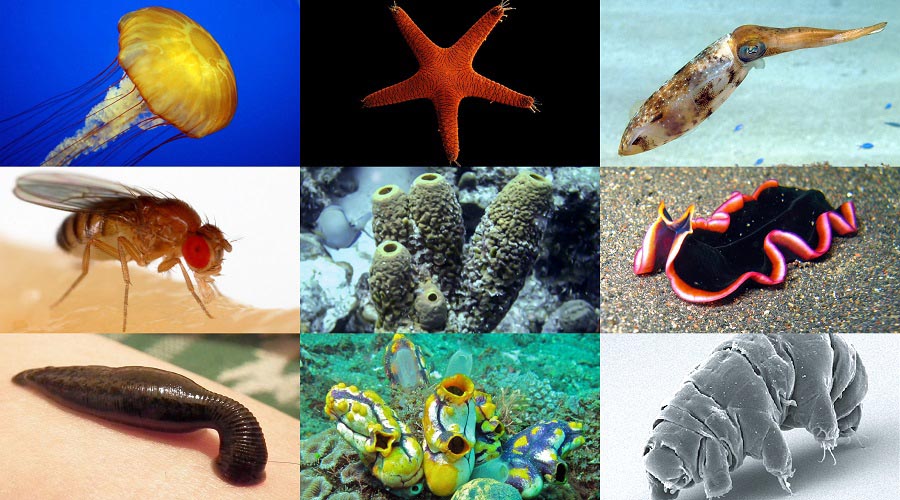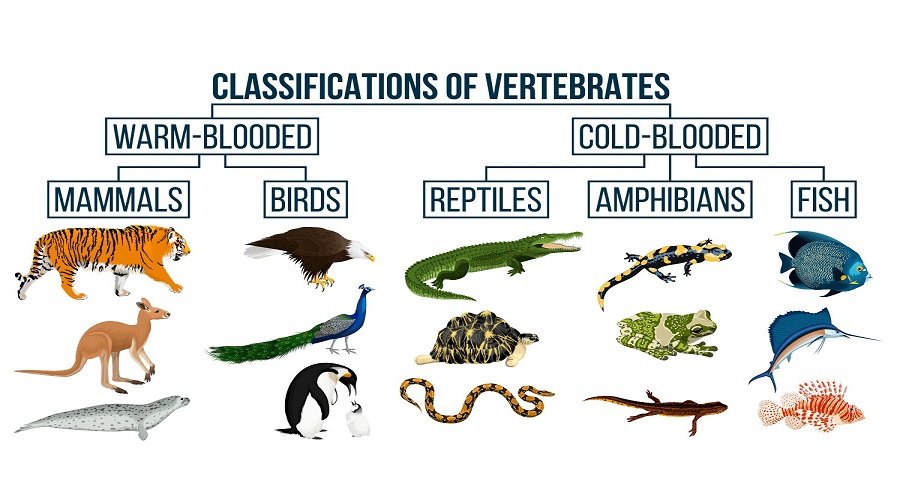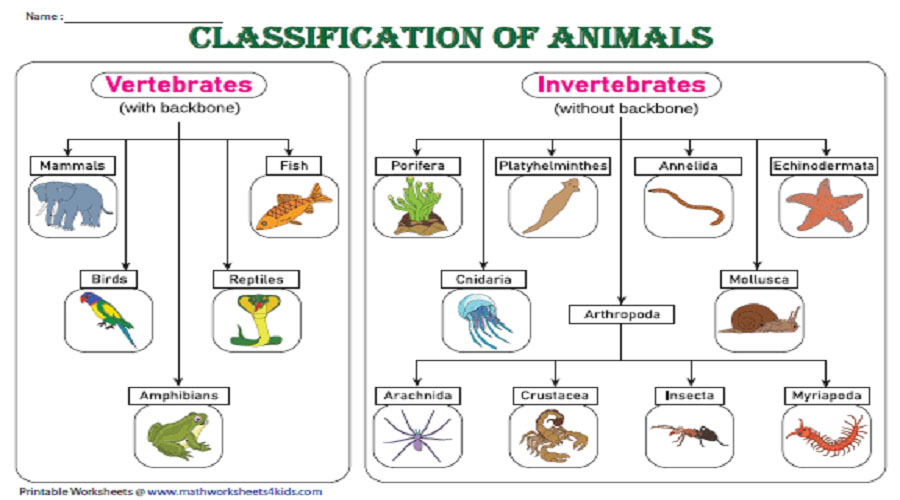Table of Contents
The categorization of animals can primarily be delineated into two divisions, namely invertebrates and vertebrates, based on the presence or absence of a vertebral column or backbone. The groups of vertebrates comprise animals such as human beings, birds, and snakes, all of which possess a backbone, while invertebrates, such as insects and flatworms, lack such a structure.
Notably, invertebrates constitute the larger proportion, representing 98 percent, of the animal kingdom, while only 2 percent comprise vertebrates. The subcategories of vertebrates can be classified into five groups, namely mammals, reptiles, amphibians, birds, and fish; in comparison, vertebrates are classified into 30 phyla.
Differences Between Invertebrates And Vertebrates

Classification of animals vertebrates and invertebrates
| Invertebrates | Vertebrates |
| Invertebrates do not possess a backbone not an internal skeleton | Vertebrates possess a backbone and an internal skeleton. |
| Invertebrates have an exoskeleton | Vertebrates do not possess an exoskeleton. |
| Body size varies but most are generally smaller than vertebrates. However, some invertebrates grow to gigantic proportions – such as the colossal squid (46 feet in length) | Generally, vertebrates are comparatively larger than invertebrates |
| Nearly all invertebrates possess an open circulatory system. | All vertebrates have closed circulatory systems. |
| A majority of invertebrates have compound eyes. | Vertebrates do not have compound eyes. |
| Includes radial or bilateral body symmetry. | All vertebrates have bilateral body symmetry. |
| Presence of a simple and unorganized nervous system. | Presence of complex and highly specialized organ systems with specific functions. |
| Mode of nutrition includes Autotrophic, Parasitic and Heterotrophic. | Mode of nutrition is usually heterotrophic. |
| 95% of animal species are invertebrates. | 5 % of animal species are vertebrates. |
| Flatworms, arthropods, sponges, insects are a few examples of Invertebrates. | Mammals, fish, reptiles, amphibians, and birds are examples of Vertebrates. |
Invertebrates
Invertebrates, animals lacking a backbone, possess a ubiquitous presence as they can be found inhabiting a diverse range of environments, from scorching deserts to the ocean’s abyssal plains, from obscure caverns and to lofty peaks.
As previously mentioned, invertebrates are characterized by the absence of a well-developed skeletal system. Consequently, they lack the capacity to attain substantial sizes due to their non-rigid body structure. In terms of circulatory system, the majority of invertebrates feature an open one, whereby blood flows within a cavity. Additionally, most invertebrates possess a straightforward respiratory system, where gills and trachea are the most prevalent forms.

animals Invertebrates
In order to overcome the absence of an inner framework, the majority of invertebrates have developed an outer framework which safeguards their delicate internal organs. Typically composed of chitin, a glucose derivative, this material provides an effective shield for the invertebrate’s tender inner body.
The animal kingdom is comprised of over 97 percent invertebrates, which accounts for a staggering number exceeding 2 million species. The constant discovery of new species suggests that this number will continue to rise on a regular basis.
A variety of invertebrates such as annelids, arthropods, bivalves, coelenterates, echinoderms, squid, sponges, snails, and octopuses exhibit notable characteristics. In fact, certain invertebrates exhibit traits and features that surpass those of vertebrates. One such example is the colossal squid, which possesses the largest eye within the animal kingdom.
Vertebrates
The animal kingdom harbors various species, among which vertebrates are considered the most advanced owing to their well-defined internal skeleton system, which comprises a backbone. In humans, the spinal cord runs between the caudal and cranial regions, connected to nerve tissues. Furthermore, vertebrates possess comparatively more specialized and complex organ systems when matched against invertebrates. Notably, the respiratory systems of vertebrates are intricately structured and multifunctional. Alongside that, sensory organs are highly advanced, allowing vertebrates to swiftly adapt to their environment.

animals Vertebrates
The estimated quantity of vertebrates present on planet earth is approximately between 57,000 to 58,000 on average.
Chordates, including mammals, birds, fish, reptiles, and amphibians, constitute a range of vertebrates. Their common trait is their bilaterally symmetrical body structure, with a skull-enveloped brain being their defining feature.
Frequently Asked Questions
How are animals classified?
An established and fundamental approach to categorizing animals is through the identification of the backbone’s presence or absence. This classification method comprises two distinct categories: vertebrates and invertebrates, both of which are widely recognized in the scientific community.
Briefly explain the characteristics of invertebrates
One of the principal features of this particular class is the lack of a spinal cord and an internal bony skeleton. However, certain members of this class possess a firm external structure named an exoskeleton, which imparts structural stability and safeguards them from predators and their surroundings, such as crabs, lobsters, and ammonites. While the majority of members exhibit mobility, there are select exceptions, such as the sea sponge.
Briefly explain the characteristics of vertebrates
Comparing vertebrates and invertebrates, it can be said that the former are more sophisticated organisms with distinct features. One of the defining attributes of vertebrates is the presence of a backbone and an inner skeleton. Cartilage can replace bones in vertebrates, as evident in sharks, for instance. Reproduction through sexual means is another defining characteristic of vertebrates.
